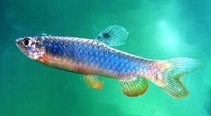Copeina guttata (Steindachner, 1876)
Redspotted tetra
Envoyez vos Photos et vidéos
Pictures | Images GoogleCopeina guttata
Picture by Landines, M.
Pictures | Images GoogleCopeina guttata
Picture by Landines, M.
Classification / Names Noms communs | Synonymes | Catalog of Fishes(Genre, Espèce) | ITIS | CoL | WoRMS | Cloffa
> Characiformes (Characins) > Lebiasinidae (Pencilfishes) > Pyrrhulininae
Eponymy: Edward Drinker Cope (1840–1897) was an American palaeontologist, anatomist, herpetologist and ichthyologist. [...] (Ref. 128868), visit book page.
More on author: Steindachner.
Eponymy: Edward Drinker Cope (1840–1897) was an American palaeontologist, anatomist, herpetologist and ichthyologist. [...] (Ref. 128868), visit book page.
More on author: Steindachner.
Issue
No recent review of the genus, studies of types and consideration of type localities suggest that there is just the one species, Copeina guttata. Myers, 1956: 12, noted that "Steindachner’s figures are erroneously labeled and should be reversed", thus figs. 6 and 5a are correct for Copeina guttata, figs. 5 and 6a for Copella nattereri. Eschmeyer, 1998:694; Vari and Howe, 1991:36; Ortega and Vari, 1986:10.
Environment: milieu / climate zone / depth range / distribution range Écologie
; eau douce pélagique. Tropical; 23°C - 28°C (Ref. 1672)
Distribution Pays | Zones FAO | Écosystèmes | Occurrences | Point map | Introductions | Faunafri
South America: middle Amazon River basin.
Taille / Poids / Âge
Feeds on worms, insects and small crustaceans (Ref. 7020).
Life cycle and mating behavior Maturité | Reproduction | Frai | Œufs | Fécondité | Larves
In captivity at spawning time, after some vigorous driving and prodding of the female, male comes alongside and slightly below the female. Male then pushes an open pocket (formed using his anal fin) below the genital opening of the female; female releases eggs into the pocket and male fertilizes them and allows them to drop into a small pit in the sand that he has previously made. Male fans the eggs with his fins until hatching, in about 24 hours, and continues to guard the fry until they are free-swimming (Ref. 7020).
Référence principale
Upload your references | Références | Coordinateur : Weitzman, Marilyn | Collaborateurs
Weitzman, M. and S.H. Weitzman, 2003. Lebiasinidae (Pencil fishes). p. 241-251. In R.E. Reis, S.O. Kullander and C.J. Ferraris, Jr. (eds.) Checklist of the Freshwater Fishes of South and Central America. Porto Alegre: EDIPUCRS, Brasil. (Ref. 37104)
Statut dans la liste rouge de l'IUCN (Ref. 130435: Version 2024-2)
Préoccupation mineure (LC) ; Date assessed: 11 September 2020
CITES
Not Evaluated
Menace pour l'homme
Harmless
Utilisations par l'homme
Pêcheries: commercial; Aquarium: Commercial
FAO - Publication: search | FishSource |
Plus d'informations
Trophic ecology
Éléments du régime alimentaire
Composition du régime alimentaire
Consommation alimentaire
Food rations
Prédateurs
Éléments du régime alimentaire
Composition du régime alimentaire
Consommation alimentaire
Food rations
Prédateurs
Population dynamics
Paramètres de croissance
Max. ages / sizes
Length-weight rel.
Length-length rel.
Fréquences de longueurs
Mass conversion
Recrutement
Abondance
Paramètres de croissance
Max. ages / sizes
Length-weight rel.
Length-length rel.
Fréquences de longueurs
Mass conversion
Recrutement
Abondance
Life cycle
Reproduction
Maturité
Maturity/Gills rel.
Fécondité
Frai
Spawning aggregations
Œufs
Développement de l'œuf
Larves
Dynamique des populations larvaires
Reproduction
Maturité
Maturity/Gills rel.
Fécondité
Frai
Spawning aggregations
Œufs
Développement de l'œuf
Larves
Dynamique des populations larvaires
Anatomy
Surface branchiale
Brain
Otolith
Surface branchiale
Brain
Otolith
Physiology
Body composition
Nutrients
Consommation d'oxygène
Type de nage
Vitesse de nage
Visual pigments
Fish sound
Diseases & Parasites
Toxicity (LC50s)
Body composition
Nutrients
Consommation d'oxygène
Type de nage
Vitesse de nage
Visual pigments
Fish sound
Diseases & Parasites
Toxicity (LC50s)
Human related
Aquaculture systems
Profils d'aquaculture
Souches
Ciguatera cases
Stamps, coins, misc.
Aquaculture systems
Profils d'aquaculture
Souches
Ciguatera cases
Stamps, coins, misc.
Outils
Bio-Quiz | E-book | Guide de terrain | Générateur de fréquences de longueur | Outil de dynamique de population | Carte par point | Classification Tree
| Catch-MSY |
Articles particuliers
Télécharger en XML
Sources Internet
AFORO (otoliths) | Aquatic Commons | BHL | Cloffa | BOLDSystems | Websites from users | FishWatcher | CISTI | Catalog of Fishes: Genre, Espèce | DiscoverLife | ECOTOX | FAO - Publication: search | Faunafri | Fishipedia | Fishtrace | GenBank: génôme, nucléotide | GloBI | Google Books | Google Scholar | Google | IGFA World Record | MitoFish | Otolith Atlas of Taiwan Fishes | PubMed | Reef Life Survey | Socotra Atlas | Arbre de Vie | Wikipedia: aller à, chercher | World Records Freshwater Fishing | Zoological Record
Estimates based on models
Phylogenetic diversity index (Ref. 82804): PD50 = 0.7500 [Uniqueness, from 0.5 = low to 2.0 = high].
Bayesian length-weight: a=0.01000 (0.00409 - 0.02444), b=3.19 (2.98 - 3.40), in cm total length, based on LWR estimates for this (Sub)family-body shape (Ref. 93245).
Niveau trophique (Ref. 69278): 3.1 ±0.33 se; based on food items.
Résilience (Ref. 120179): Milieu, temps minimum de doublement de population : 1,4 à 4,4 années (Fec = 100).
Fishing Vulnerability (Ref. 59153): Low vulnerability (10 of 100).




